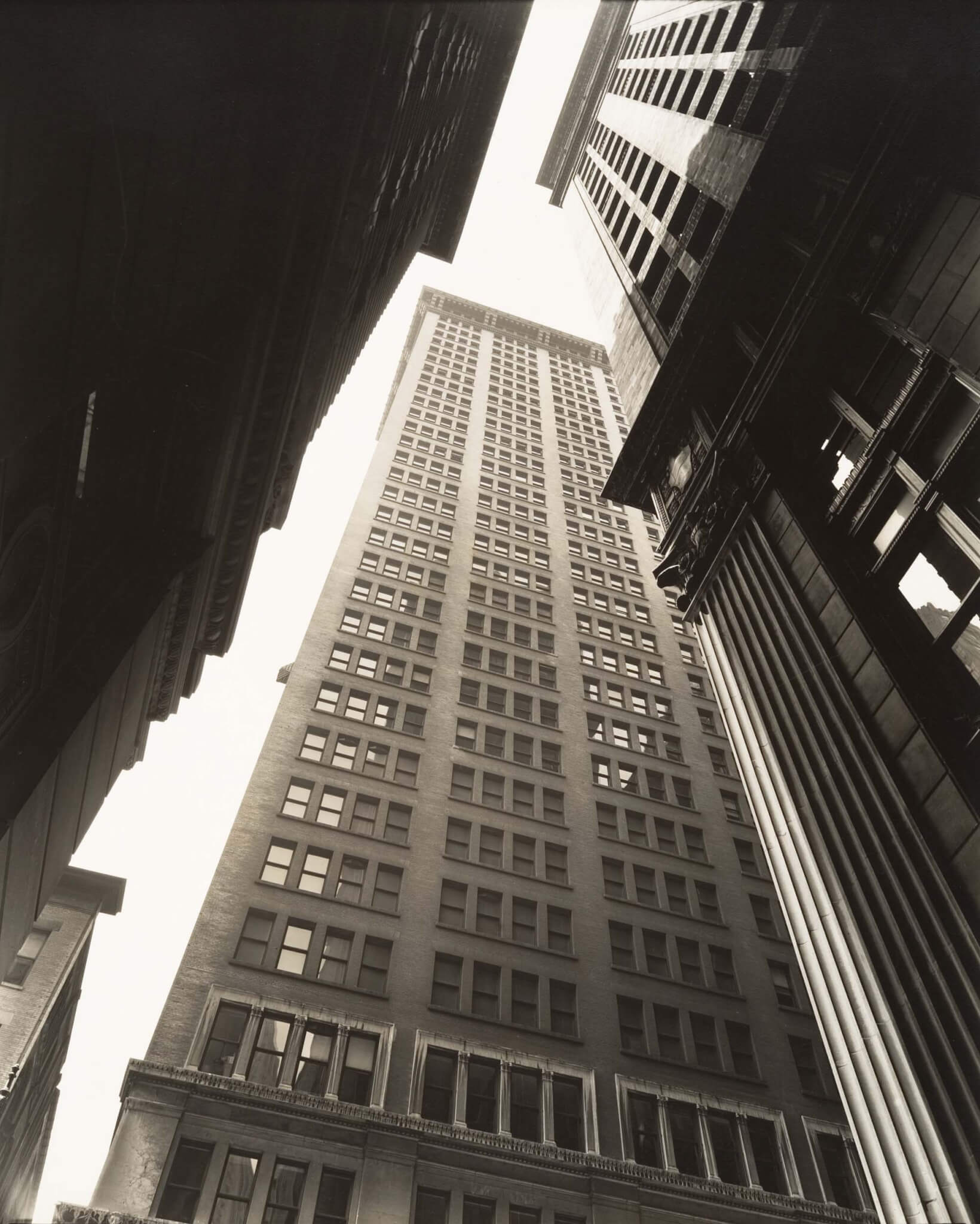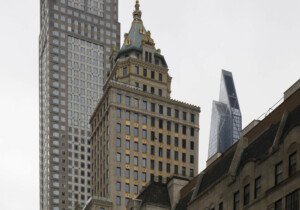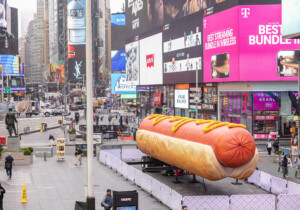Berenice Abbott’s New York Album, 1929
The Metropolitan Museum of Art
New York
Through September 4
After spending the Roaring Twenties partying in bohemian Paris, Berenice Abbott returned to New York City in 1929 on a mission. Armed with the archive of her mentor Eugène Atget and a drive to establish herself as a photographer, she set up shop at the Hotel des Artistes on West 67th Street. Between portrait gigs, she wandered the streets with a view camera and a Graflex, exploring a city remade by construction since she last lived there, in 1921. Inspired by Europe’s modernist imagery and photography—including the “Vertikal Tendenz” of skewed perspectives within angled shots—she had her film developed into small prints in drug stores and commercial labs. The time was transformative: “When I saw New York again, and stood in the dirty slush, I felt that here was the thing I had been wanting to do all my life,” she said.
Eventually, Abbott collected 266 small prints and arranged them on a photo album’s 32 pages. Each is roughly letter sized and faced in black construction paper, with two holes punched on the left side to affix into a binder. Decades later, she gifted the item to The Met; it was restored prior to becoming the centerpiece of this exhibition.
The album represents a remarkable turn in Abbott’s career. It was made at a time when she was moving beyond Atget’s influence: Advancing beyond the bread-and-butter work of portraiture, it was the moment when she first identified the city as her subject. Mia Fineman, a curator in the Department of Photographs at The Met, reinforced this idea of the book as a moment of redirection, positioning the scrapbook itself as a hinge in Abbott’s career, an idea that’s reinforced by the exhibition design.


Visitors enter Abbott’s world pre-scrapbook, passing through a threshold painted warm red. Earlier works are displayed alongside portraits by Atget, offering context, before visitors arrive at the contents of the scrapbook itself. Forming the core of the show, the sequence is actually only definitively known through the book’s first 11 pages, as the set arrived unbound when The Met acquired it sometime between 1978 and 1984. (Overall, about 75 percent of the album is on view here.) Photos are laid out with care in arrangements that respond to subject matter, orientation, and geometry. There are pages of signage, docks, workers, and parades, but also abstract prints of skyscrapers with shadows cutting across the canyons of Lower Manhattan. With the expertise of historian Celedonia “Cal” Jones, many locations of Abbott’s photographs have been identified, and the Met has mapped them on a Google map available online.


The show culminates with later works and side-by-side comparisons to contemporaries like Margaret Bourke-White, Walker Evans, and Paul Grotz. It also includes a glass display case holding a copy of Abbott’s influential photobook, Changing New York. First published in 1939, it shows how an entire capital-P Project grew from the photographic explorations first glimpsed in a dime-store print. Notably, the volume featured text written by Elizabeth McCausland, Abbott’s longtime romantic and creative partner. The pair met in 1935 and were quickly exchanging flirty letters. Early in 1936, they moved into adjacent studio apartments in Greenwich Village—one for living, one for sleeping. The couple lived there (and bathed via sink-wet sponge baths) until McCausland’s death in 1965.

The album deserves to be understood within the arc of Abbott’s life, a subject expertly chronicled in Julia Van Haaften’s biography, published in 2018, which captures the artist’s creative work in addition to her lesbian relationships and leftist politics. Beginning in 1918, a young Abbott spent three years in Greenwich Village as part of New York’s avant garde after escaping Ohio, where she grew up. She did nude modeling for Man Ray and bummed around with bohemians like Eugene O’Neill and Edna St. Vincent Millay. She tried her hand at sculpture; later, she’d be the subject for a bust by a young Isamu Noguchi. Abbott followed Ray to the culturally bustling 1920s Paris, where she began working as his studio assistant for portrait commissions. She learned about cameras and darkrooms before realizing her own first photographs in his studio after-hours. Eventually, interest grew in working with Abbott directly: When Peggy Guggenheim requested to work with her instead of Ray, she knew she had to strike out on her own.

In New York, Abbott’s turn away from human subjects and toward cities brought her into working relationships with architectural influencers of the era. She was friendly with fellow Ohio transplant Philip Johnson, who supported her work in the early 1930s. (Abbott’s politics later intervened: The “two friends later parted ways over Johnson’s political views and his enthusiasm for the Third Reich,” Van Haaften wrote.) In 1934, Abbott would serve in as a driver-photographer for historian Henry-Russell Hitchcock as he documented the work of H. H. Richardson and vernacular, pre–Civil War buildings.

Early in his recent book A Theory of Assembly, Kyle Parry defines the act of assembly:
Assembly places expressive relationships front and center. To assemble is to convene, collate, and compile. It is to organize, arrange, and configure. An assembly is any combination of expressive elements that maintains and seizes on the appearance of selection and arrangement.
Abbott’s pages, with this scholarship in mind, are assemblies: They configure a set of images into relationships with one another, and meaning is generated from this web of graphic conditions. The layouts were influenced by the adventurous graphics Abbott encountered during her time in Europe; they are more like a catalog or portfolio meant for editors rather than something intended for public viewing. It sort of worked: Two of the shots were published in the August 1929 issue of Variétés, a Belgian avant-garde magazine, also on display.
While each artifact can be assessed for its own compositional merits, the strength of the album—and the treat of the show—is witnessing Abbott’s arrangements. Seeing the pages as single units centers the relationships between and among images. When we look at the album, we’re seeing Abbott’s vision twice: first in her photographs, and then in her assemblages of those works.

The Met’s exhibition makes the argument that a key artistic inflection point for Abbott’s career is this humble book of snapshots. She set out to make New York’s modernity her subject, much like Atget had done with Paris. And she succeeded, in time: Her 1930s works like Nightview and Exchange Place capture a city upheaved, with the metal-and-glass protuberances of the 20th century rising among the bricked masses of the 19th century. But the chaotic juxtapositions of civic life are given order through Abbott’s snaps. The album is a tender document of a young photographer’s growth.

Perhaps today we would see these assemblies as Instagram carousels or a zine, a Miro board, or a Pinterest profile. Almost a century ago, a scrapbook did the trick, and the results, on view through Labor Day, reward close inspection.










